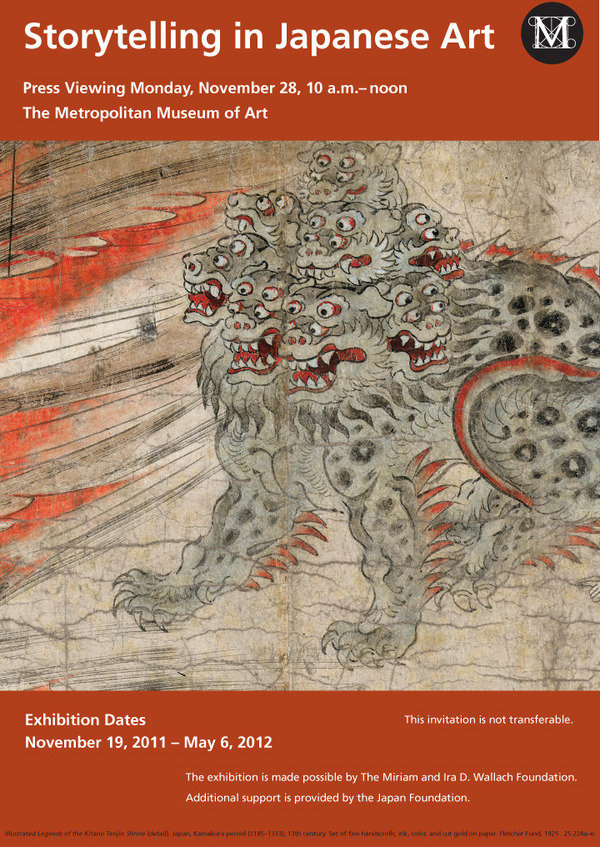Storytelling in Japanese Art
dal 27/11/2011 al 5/5/2012
Segnalato da
27/11/2011
Storytelling in Japanese Art
Metropolitan Museum of Art - MET, New York
Showcasing more than 90 vibrant works drawn from the New York Public Library and other local collections, as well as works from the Metropolitan's own holdings, Storytelling in Japanese Art will trace the rich history of illustrated narratives that thrived in the medieval and early modern periods of Japan. The focus of the exhibition will be on some 20 rare illustrated handscrolls called emaki.

Japan has enjoyed a long tradition of storytelling through paintings and illustrated books, which continues today in the popular art of manga (comic books for children and adults). Showcasing more than 90 vibrant works drawn from the New York Public Library and other local collections, as well as works from the Metropolitan’s own holdings, Storytelling in Japanese Art will trace the rich history of illustrated narratives that thrived in the medieval and early modern periods of Japan. The focus of the exhibition will be on some 20 rare illustrated handscrolls called emaki. Highlights among them will be: an exceptional fragment of the set of handscrolls nicknamed Frolicking Animals, whose parent scrolls in Japan have the designation of National Treasure and are often referred to as ancestors of modern manga; The Tale of the Drunken Demon, capturing a dramatic and gory scene of a warrior chopping off a demon’s head; and the Illustrated Legend of Kitano Shrine, a set of five handscrolls that will be displayed simultaneously for the first time. Dating from the 12th to the 19th century, the exhibition will also include works in other formats: handscroll, fan, book, and screen.
The exhibition is made possible by The Miriam and Ira D. Wallach Foundation.
Additional support is provided by the Japan Foundation.
Illustrated handscrolls, or emaki, represent an artistic tradition that stretches back to the eighth century in Japan. Extant emaki from the 12th and 13th centuries represent the quintessence of narrative presentation in this highly developed format. The tales, many now part of the canon of classical Japanese literature, include miraculous events of the Buddhist and Shinto religious traditions, romantic trysts of courtiers and court ladies, heroic adventures of men and women during times of war, and antics of animals in the roles of humans, not to mention the macabre escapades of ghosts and monsters.
Other highlights of the exhibition include rarely seen masterworks such as A Long Tale for an Autumn Night, a homoerotic tale of a romance between a Buddhist monk and a young male novice. The exhibition also will feature works in various formats illustrating dramatic episodes from The Great Woven Cap, a tale of Fujiwara no Kamatari, the founder of the powerful Fujiwara clan; in its climactic scene, a female diver is chased by a dragon.
Some 20 works of art will be rotated into the exhibition in February.
The exhibition will include full views of some of the handscrolls in the exhibition on iPad displays within an exhibition reading area. A lavishly illustrated publication and an Audio Guide will also be available.
The Audio Guide of the exhibition will be available for rental ($7, $6 for members, and $5 for children under 12).
The Audio Guide is sponsored by Bloomberg.
In conjunction with the exhibition, a variety of education programs will offer various audiences opportunities to consider the themes and visual richness of the show. These include a Sunday at the Met on February 26; gallery talks; a special afternoon gallery workshop exploring storytelling traditions in Asian art; films; and a manga workshop for teens connecting works in Nolen Library’s new graphic novel collection with in-gallery explorations of the exhibition. Unless otherwise noted, all programs are free with Museum admission.
Education programs are made possible by the J. C. C. Fund of the Japanese Chamber of Commerce and Industry of New York.
The Sunday at the Met is made possible in part by the Japan Foundation.
The exhibition will be featured on the Museum’s website (www.metmuseum.org).
Storytelling in Japanese Art is organized by Masako Watanabe, Senior Research Associate in the Department of Asian Art at The Metropolitan Museum of Art. Exhibition design is by Daniel Kershaw, Exhibition Design Manager; graphics are by Sophia Geronimus, Graphic Design Manager; and lighting is by Clint Ross Coller and Richard Lichte, Lighting Design Managers, all of the Metropolitan Museum’s Design Department.
Location: The Sackler Wing Galleries for the Arts of Japan, 2nd Floor
Press viewing: Monday, November 28, 10:00 a.m.–noon
Metropolitan Museum of Art
1000 Fifth Avenue at 82nd Street - New York
Hours: Tuesday–Thursday: 9:30 a.m.–5:30 p.m.
Friday and Saturday: 9:30 a.m.–9:00 p.m. Sunday: 9:30 a.m.–5:30 p.m.
Admission: Adults $25 Seniors (65 and older) $17 Students $12*
Members (Join Now) Free
Children under 12 (accompanied by an adult) Free



